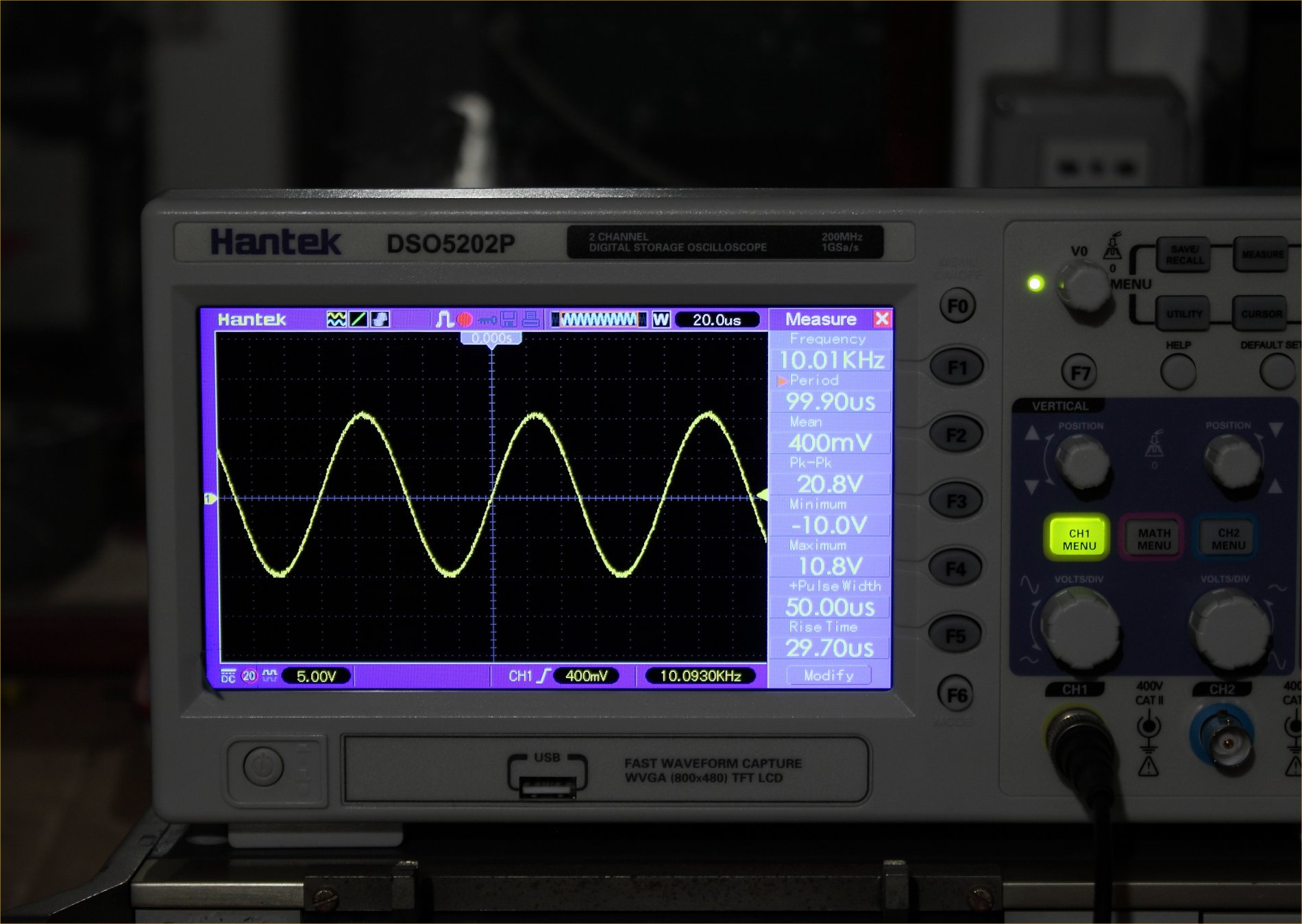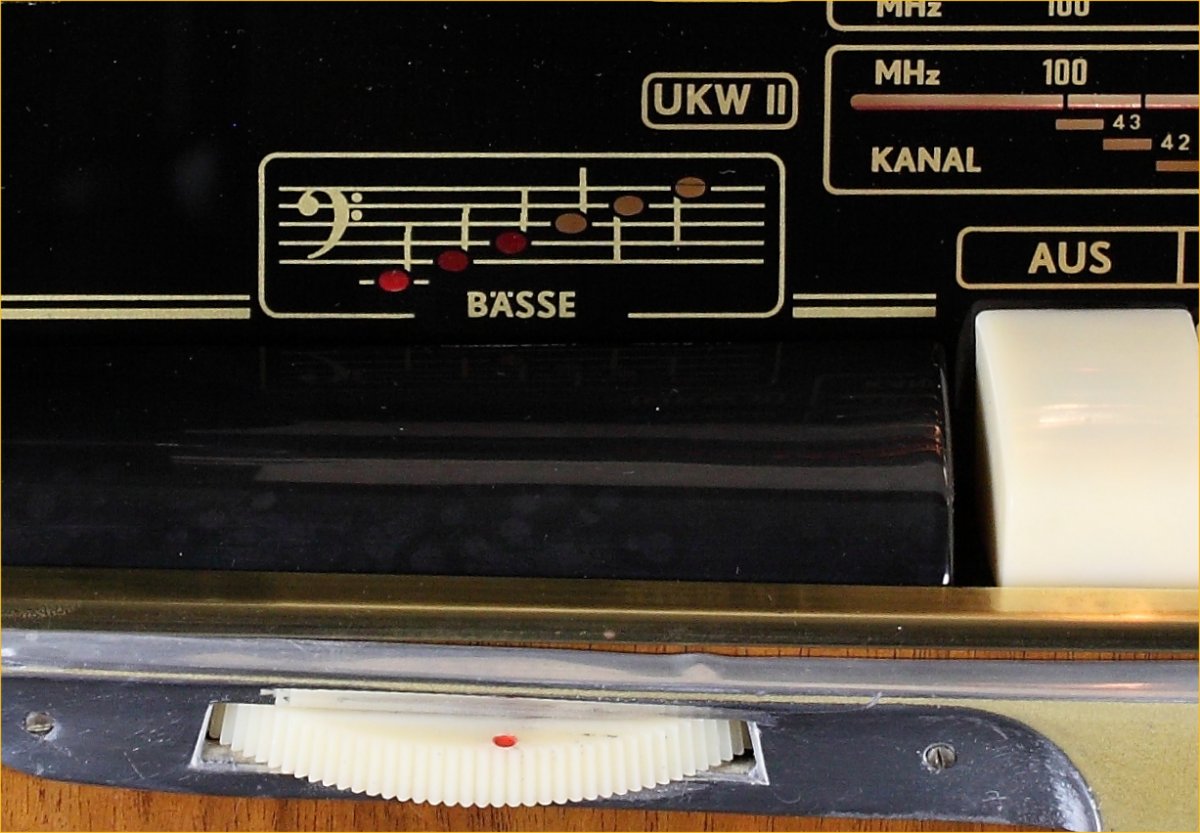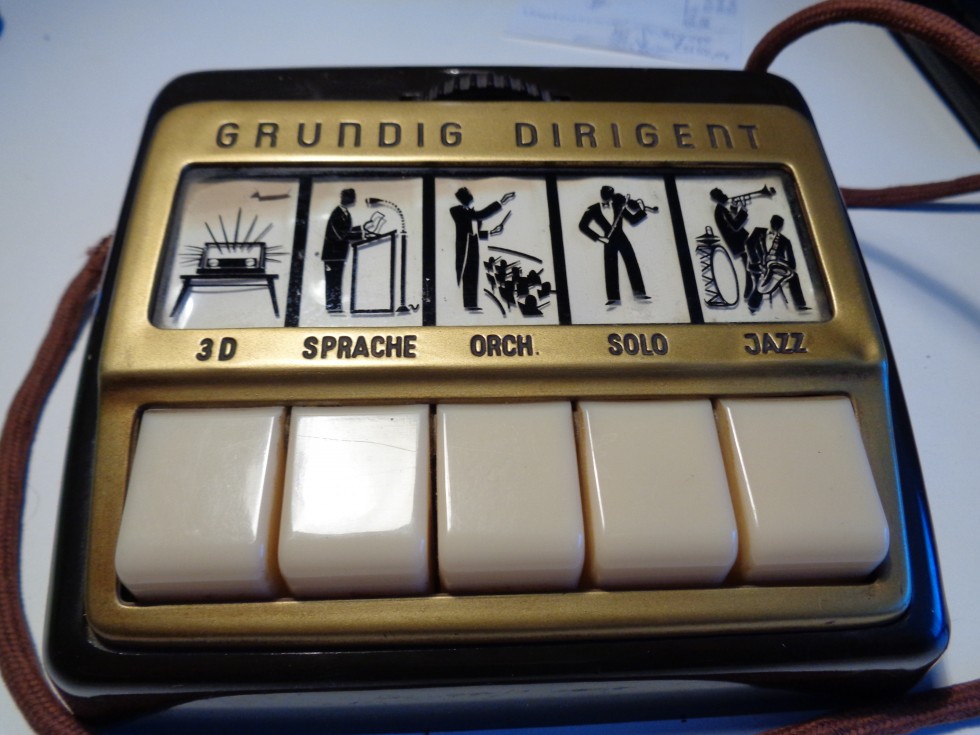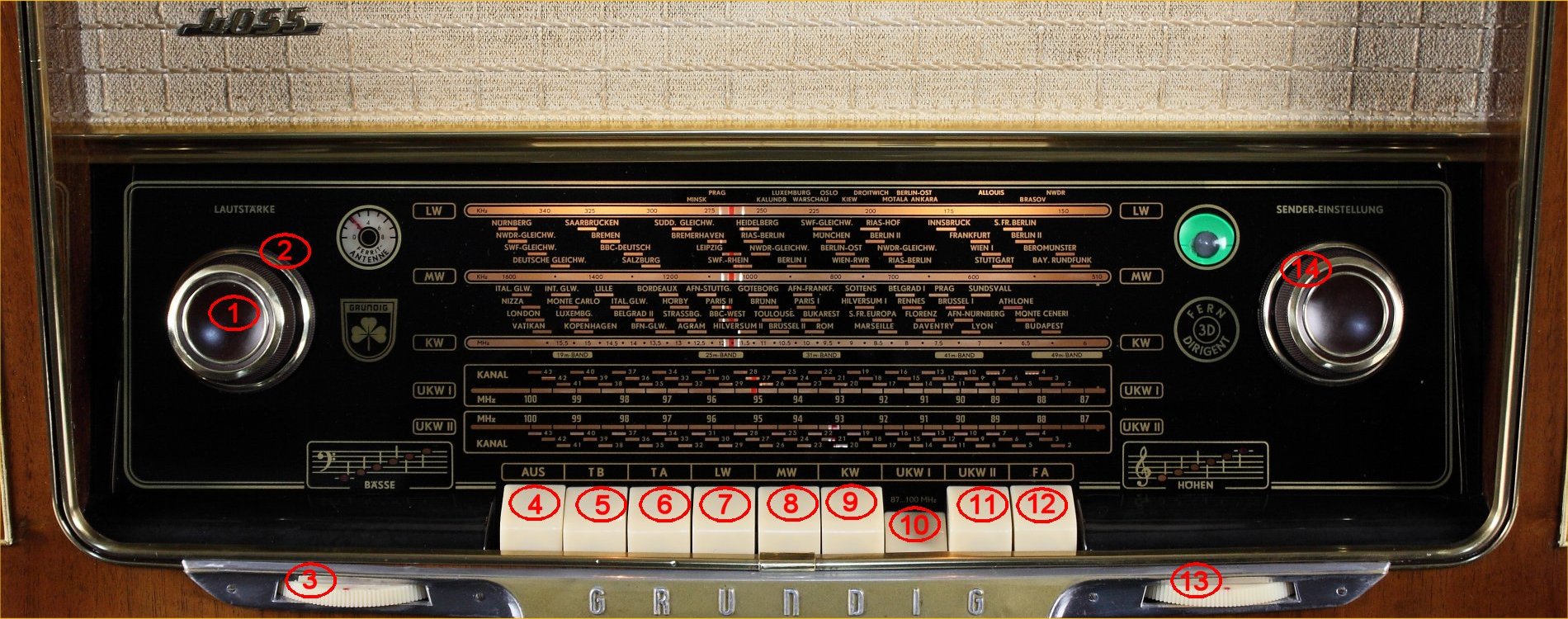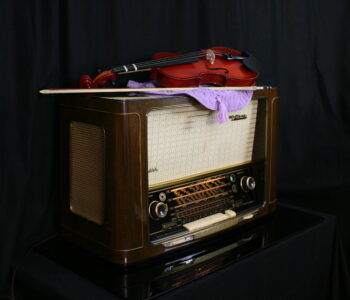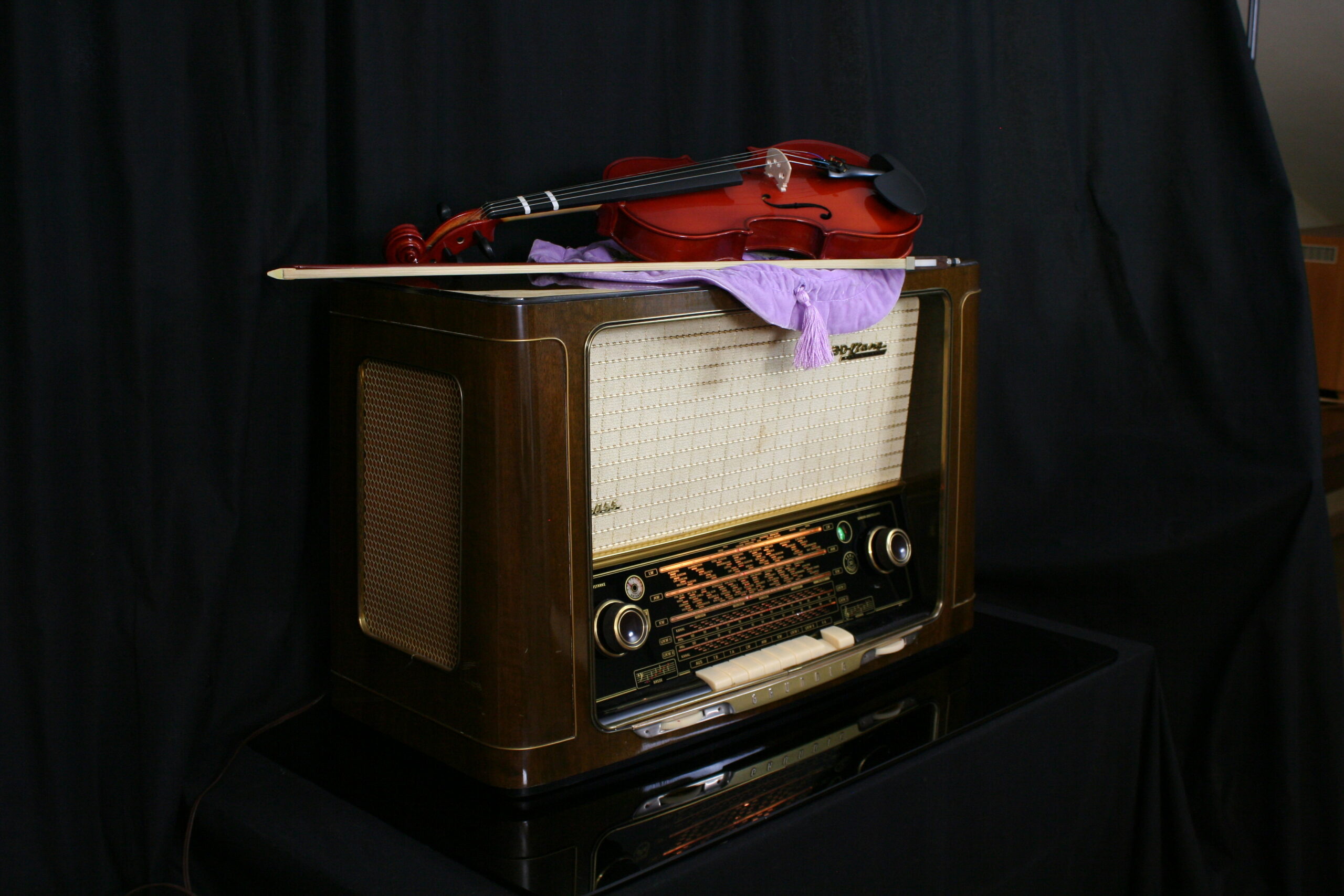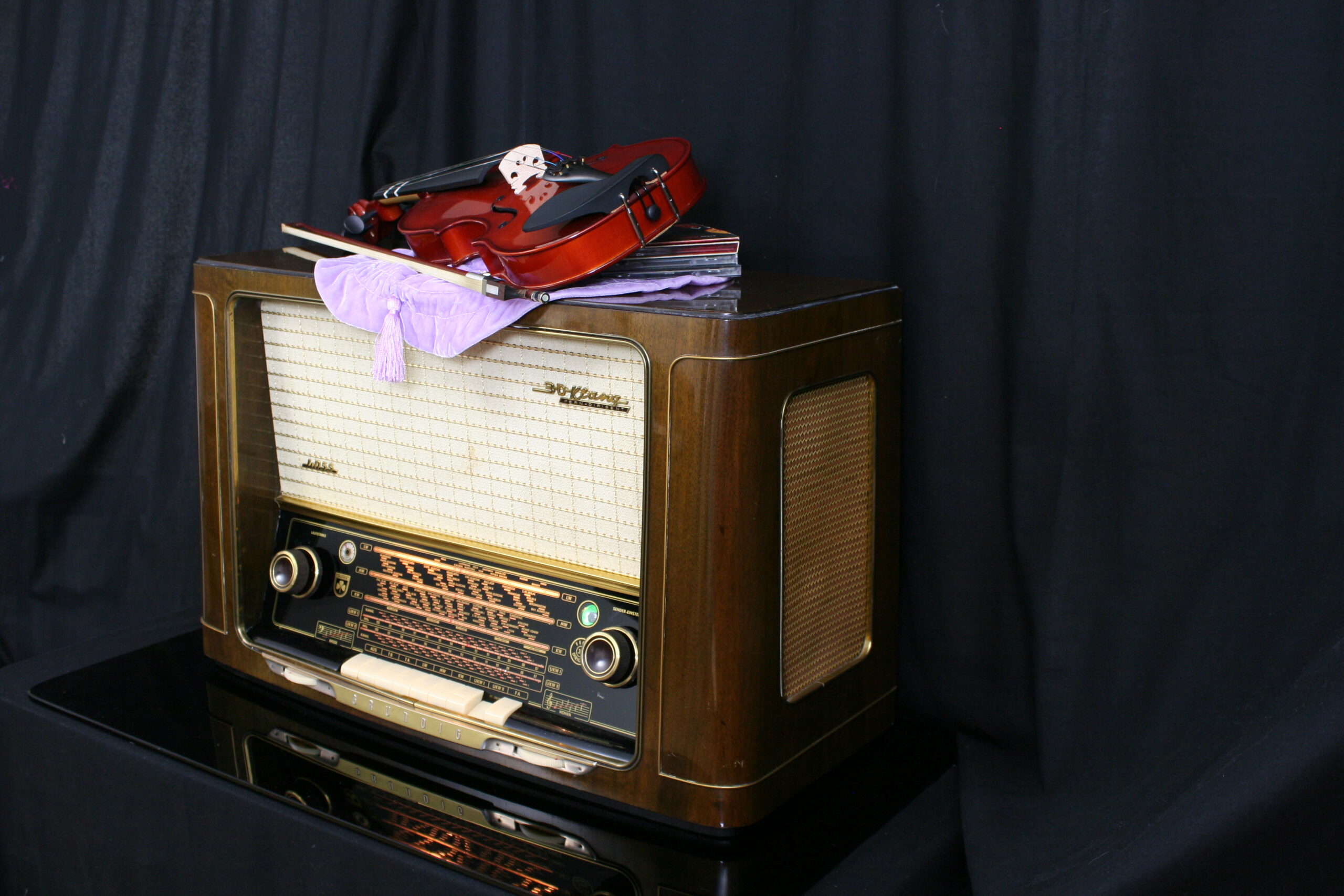 4055 - en
4055 - en
Grundig 4055/56 Enhanced- en
- 1st February 202415th February 2024
- by giovanni
Grundig 4055/56 enhanced
Also this reviews will be accompanied by a section with graphs of technical measures of the most important parameters.
There is no such thing anywhere else, as far as I know. Not even the manufacturers themselves detailed the technical features of their own devices at this level.
This new section has been developed for an objective comparison of different devices.
In order to avoid interpreting the measurements incorrectly, it is very important to read the warnings carefully the first time.
The Grundig 4055/56 was the most prestigious model produced by the German company in 1956.
The FM converter stage is particularly interesting. In fact, it is equipped with double amplifier and oscillator circuits that can be selected via two buttons on the front. Furthermore, in the dialglass there are two identical FM bands, FM1 and FM2. Pressing the UKWI button and rotating the tuning knob will move the UKWI scale indicator, pressing the UKWII button and rotating the tuning knob will move the UKWII scale indicator. In this way it is possible to store an FM station in the UKWI band and another FM station in the UKWII band. The Grundig 3055 and 4055 are the only radios in the entire German production of that period to have two FM bands, but the 4055 is the only one to also have a Push-Pull final stage.
Unlike the previous model, Grundig 4055W/3D, the 4055/56 model is equipped with a rear socket for the remote control. The remote control allows you to turn the device on and off, change the volume and choose one of the predefined equalizations on the remote control.
The low frequency stage is an excellent example of a Push-Pull amplifier, with two EL84s with well-known sonic characteristics.
The phase inverter stage is made up of an Ebc41 triode, the preamplifier is made up of the triode section of an EABC80. The circuit is classic and very proven. The high sound quality is given by the excellent quality of the output transformer and its considerable size, which together with the good quality of the air gap laminations and the alternate winding of the copper layers reaches saturation very late.
The feedback circuit as usual, is moderate, and affects the response curve. The resulting sound is very open, with great presence in the mid and high tones and sufficiently damped bass.
The cabinet is very robust and free of vibrations and resonances.
The speakers:
There are five speakers, three on the front and two on the sides.
These is a very bug full-range speakers and two electrostatic tweeters on front. On the sides we find two elliptical widebands.
The entire frequency range is sent to these full-range speakers with a slight cut in the upper part, in reality the actual cut in the high part occurs mechanically.
The front canvas covering the speakers is never completely transparent from an acoustic point of view.
For this reason the only way to obtain maximum performance from the appliance is to eliminate it.
We can build a false frame in which the original canvas is installed. This frame attaches to the speaker panel with magnets.
In this way it is possible to detach it when you want to listen to music with maximum transparency and put it back in its place when the radio is at rest to protect the speakers from dust and to restore the original aesthetic appearance of the device.
All this translates into exciting dynamics, brilliance of sound, lack of canvas oscillations in the presence of low frequencies, making listening to this beautiful device very realistic and pleasant.
The first song is by Pink Anderson, it is Baby Please Don't Go. Pinkney Anderson was born in Laurens, South Carolina on February 12, 1900. At 14 he joined Dr. Kerr of the Indian Remedy Company to sing and dance to the public in the streets while Kerr sold his elixirs which he said had medicinal properties. In 1928 she recorded for the Columbia label. In the 50s and 60s she recorded other albums and performed live. She died in 1974 of a heart attack. The song "Baby Please Don't Go" tell about the anxiety of a recluse over the departure of his lover who is about to leave him to return home to New Orleans.
The second song is by Floyd Council, it is called Looking For My Baby. Council was born in Chapel Hill, North Carolina, on September 2, 1911. At 15 he performed on the streets of Chapel Hill with two brothers, Leo and Thomas Strowd. In the late 1920s and early 1930s he and Blind Boy Fuller busked in the Chapel Hill area. In the 1930s he recorded some songs for ARC but very few Council recordings remain. In a 1969 interview, Council stated that he had recorded 27 songs over the course of his career, seven of them as backing tracks to Blind Boy Fuller. In the late 1960s he suffered a stroke that partially paralyzed his throat muscles and slowed his motor skills. Peter B. Lowry attempted to record it in 1970 but Council was unable to sing or play. Council died in 1976 of a heart attack.
The third song is naturally by Pink Floyd and it is a rare live recording, Live at the Rainbow Theatre from 1972 . Syd Barrett created the band's name by juxtaposing the first names of the two bluesmen Pink Anderson and Floyd Council. Pink Floyd's most famous LP, "The dark side of the moon" was the product of an intense year of laboratory work, tested and perfected thanks to over a dozen live bootlegs such as this recording at the Rainbow Theatre. The arrangements of these recordings often vary greatly from the final LP. Unfortunately the recording is of very poor quality, but for enthusiasts this is certainly not a problem.
The fourth song is O Tempo E O Lugar by Ana Caram. The song is by Sueli Correa Costa, the talented Brazilian singer-songwriter who died last year. She recorded for EMI with important partners such as Cacaso and Tite de Lamos. She sang about love like few others and left a definitive mark on our music, with songs that had the rare combination of sophistication, elaboration and beauty, fluidity and the ability to reach a wide audience. Her compositions, however, have been interpreted by artists such as Simone, Elis Regina, Fagner, Maria Bethânia, Gal Costa, Beth Carvalho among many others.
The fifth song is Litany by Arvo part. A characteristic of his style is that his songs arise from silence, grow, loading themselves with effect and then descend back towards silence. This technique originates from Part's initial twelve-tone influences, especially from Webern, although Part ideologically abandoned this current, realizing that it carried within itself the seeds of a conflict, in particular against capitalism. Coming to the firm belief that every conflict originates within oneself.
Having been commissioned by the Oregon Bach Festival, Litany Part uses the English language for the first time. The text is by Giovanni Grisostomo, a great theologian born in Antioch in Syria (currently in Turkey). The English terms being short do not allow for a structured musical elaboration, however the initial dialogue between the prayer and the immediate, or rather anticipated, response of the violin indicate the response from heaven. Before man can ask God for help, God is already close to him.
The sixth song is Il Cielo In Una Stanza performed by Mina. Gino Paoli's most famous song had a very troubled origin. He was judged by Giulio Rapetti (aka Mogol) with phrases like "this is not a song", "it's better for you to change jobs", "it absolutely can't go" and even worse by Miranda Martino who refused to interpret it. Then Mina arrived and wanted her to sing it instead. Arranged by Tony de Vita, Mina, as soon as she finished singing it, started crying and all the musicians stood up moved.
The song talks about orgasm and is dedicated to a prostitute with whom Paoli had fallen in love. In the song the unsaid suggests sensuality with the description of the environment.
BLUETOOTH
Bluetooth receiver embed
MULTI PLATFORM CONNECTION
Each radio is equipped with a cable for connection to any digital device.
TUBESOUND IMPROVEMENT
– Bluetooth receiver embed – The unit is equipped with a BLUETOOTH receiver powered directly by the receiver power supply. This makes it possible to control the amplifier from any external digital device as an IPAD, a Smartphone, or a sophisticated multimedia station. So you can hear your preferred web station or your lossesless file without cables on the room. Wireless Receiver can be equipped upon requests.
– Multi Platform Connection – A customized adaptation cable to connect any digital device as Iphone, Smartphone, Laptop, CD Player etc. will be provided with this radio. This special cable suits the different impedances between the modern equipment and the receiver. Furthermore the two stereo channels flow into one without increasing the load to the input unit.
HISTORY
1930 - At 22 years old Max Grundig begin a radio repair business.
1939 - The II world War start. Grundig works primarily for the Wehrmacht and repair of telecommunication equipment.
1945 - Immediately after the war, the demand for repair work was very great. Max Grundig built the first two Grundig appliances: the Tubatest tube tester and the Novatest testing device.
1947 - Start the sale of a kit radio, the Heinzelmann. The unit is the basis of success, sold more than 15,000 pieces.
1950 - Very high frequency (VHF) is introduced to Germany and places new demands on the industry. Grundig launches the 380 W on the market.
1952 - The first television channel starts up in Germany. After intensive research, Grundig launches the FS 080 onto the market. In the same year the first portable tape recorder Reporter 500 L is created.
1956 - After a lot of radio produced with progrssively high performances was produced the Concert Radio 5080 equipped with an equaliser, which has five controls and a visual display.
1965 - A new factory is established in Braga, Portugal. The Satellit 205 is one of many appliances in the Satellit series. This product marks the beginning of Grundig production of high-quality global receivers.
1970 - The Audiorama 7000 Hi-fi was produced, it has twelve dynamic speaker systems in one speaker.
1976 - The Reel Tape Recorder TS 1000 is equipped for semi-professional use.
1980 - The slim-line Hi-fi Tuner ST 6000 and the Monolith Hi-fi Dynamic Flat Top Antenna, which has 22 speaker systems, are two particularly popular appliances in the new hi-fi range.
1984 - After severe drop in sales Philips increased its stake in Grundig 31.6 percent and takes over the corporate management.
1997 - Philips pulls out of its involvement with Grundig.
2003 - The company files for bankruptcy.
2008 - Turkey's Koç Holding took full ownership of Grundig Multimedia B.V., the parent company of Grundig Intermedia GmbH in Nuremberg.
Courtesy of: Grundig
MAIN FEATURES
Year of production: 1956
Superheterodyne IF 468/10700
9 AM circuits
13 FM circuits
Wavebands:
Medium wave (MW), Long wave (LW),Short wave, FM1 (UKWI), FM2 (UKWII)
Loudspeakers:
1 elliptic wideband
2 electrostatic Tweeter
2 cone Mid/Tweeter
Dimensions (LHD): 706 x 444 x 300 mm / 27.8 x 17.5 x 11.8 inch
Net weight: 17.6 kg / 38 lb 12.3 oz
9 tubes: ECC85 ECH81 EF89 EF80 EM34 EABC80 EBC41 2xEL84
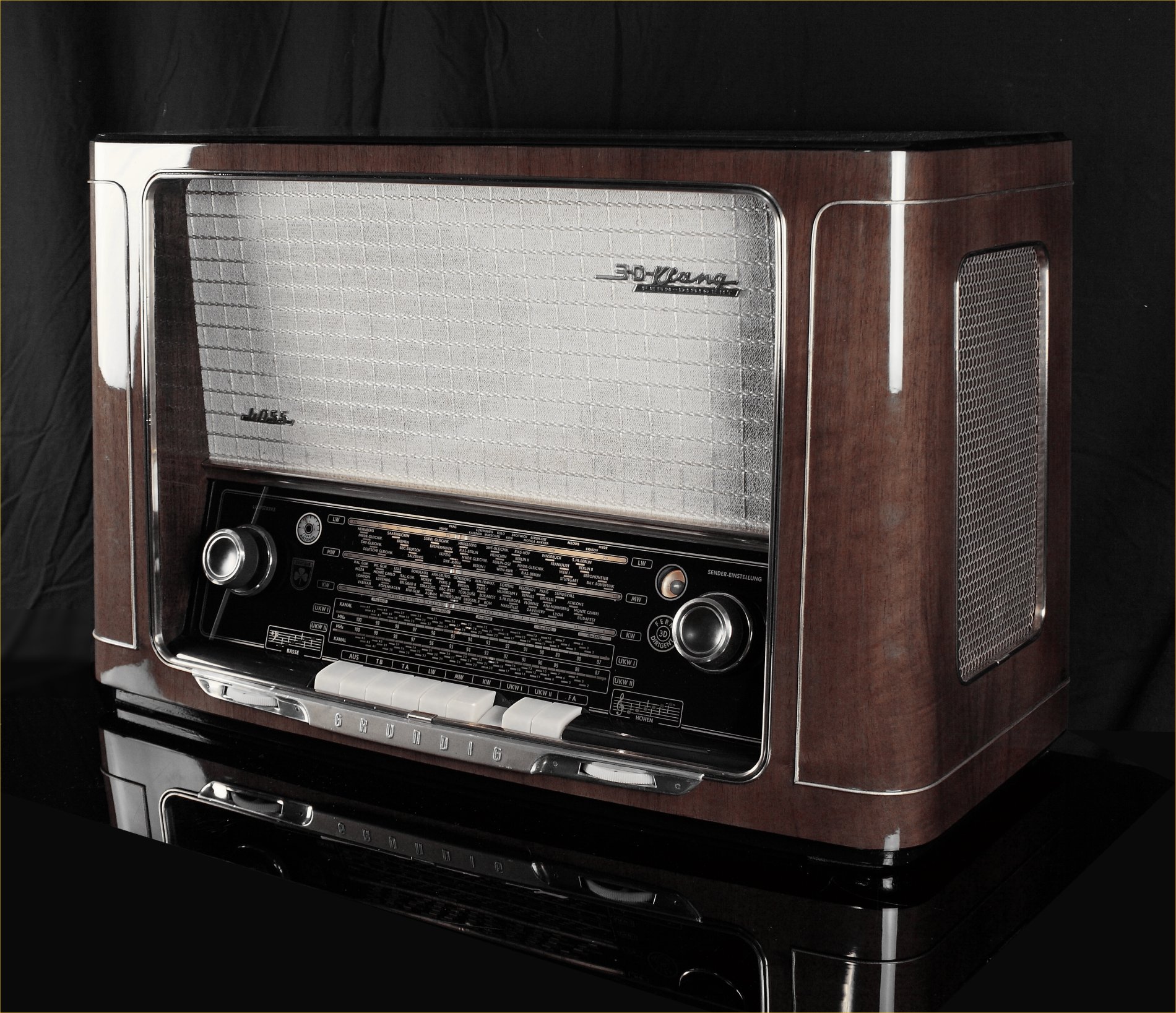
MEASURED TECHNICAL FEATURES
IMPORTANT REMARK
(to be read carefully at least the first time)
- The following measures have been carried out in order to compare, from an electrical point of view, the devices that will be reviewed on this site. It is not possible to make comparisons with measurements made by other laboratories on different devices. The instrumentation and measurement conditions are probably very different.
- The instrumentation used for the measurements is obsolete and unprofessional. We believe that more precise instrumentation is not necessary due to the tolerances of the human auditory system. Distinguishing a distortion of 1% from one of 1.1% or 1.001% only makes sense from the electrical point of view. Probably no one can hear the difference by ear. Only a child and very few lucky people can perceive the difference between a flat response curve up to 16 KHz and one up to 20 kHz.
- The perception of sound depends on many factors, namely the age of the listener, the listening environment, the musical genre that is being reproduced, the listener's expectations, his or her listening habits and knowledge and many other factors, besides of course the quality of the other devices. Therefore, there is no direct and unique relationship between the results of the measurements made and the pleasantness of listening to a specific device.
BANDWIDTH
Normally the measurement of the bandwidth is done on a resistive load. Therefore, the deformation caused by the loudspeakers' inductive load and the effect of the mechanical resonance of the speakers themselves on the feedback circuit are not considered. The effects are by no means negligible, the measurements carried out on a purely resistive load are always very linear but they don't coincide with the real frequency response.
On the other hand, this response curve was measured on an inductive laod, that is, with its own loudspeakers.
The frequency response measurements were made with a sinusoidal generator and a Wandel & Goltermann WM – 20 level meter.
You can see the actual frequency response on the vobulator' screen.
RMS POWER
he lower of the RMS voltages measured at the three sample frequencies divided by the load resistence.
The measurement conditions are the following:
- sample frequencies, 100, 1000, 10,000 Hz
- 8 ohm resistive load
- distortion less than or equal to 1%.
The measuring instrument provides the RMS value directly.
The measured RMS power is 7,2 W
INTERMODULATION DISTORTION %
The Intermodulation Distortion % was measured with the SMPTE standard and measured at 1W RMS.
The two measurements were carried out by modulating the 50 Hz sine wave with a 1080 Hz sine wave and then with a 10400 Hz sine wave, with an amplitude in a ratio of 1/4 compared to the basic sinusoid.
The output voltage was kept around 2.83V on an 8 ohm carico.
The measured Intermodulation Distortion % (IM%) is 0.23%
TONE CONTROL WITH LEVEL INDICATION
AERIALS
Inside the cabinet there is a dipole for FM reception and a ferrite rotating aerial for AM reception.
Ferrite aerial can be rotated from the outside to achieve a perfect tuning of the device in the AM.
In this picture you can see the rotation mechanism, and the aerial position indicator.
The reception sensitivity with internal aerials is very good. This unit was in fact produced when there were not many radio stations, and those available were far from each other.
Using an external aerial sensitivity is further increased.

FERN-DIRIGENT
Connection for remote control (fern-dirigent) which allows you to control the ignition, volume and equalization.
Below, on the right, you can see the "remote control" diagram.
It is not easy to find, very few have been sold in Italy, the price of the (fern-dirigent) ranges from €350 upwards.
1 - Volume control (with built-in loudness)
2 - Ferrite antenna rotation control.
3 - The bass control knob
4 - Switching off
5 - Recorder
6 - Turntable
7 - Long Waves
8 - Medium Waves
9 - Shortwave
10 - FM 1
11 - FM 2
12 - Ferrite antenna for medium and long waves
13 - The treble control knob
14 - Tuning knob
THE USUAL AMAZING LAST IMAGE




































